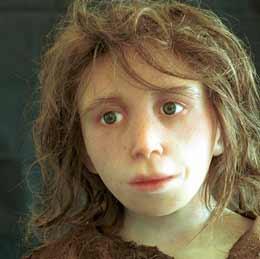Genetic data points to ancient liaisons between species.
 An interspecies love child?Christoph P.E. Zollikofer
An interspecies love child?Christoph P.E. ZollikoferThe discovery, presented at the annual meeting of the American Association of Physical Anthropologists in Albuquerque, New Mexico, on 17 April, adds important new details to the evolutionary history of the human species. And it may help explain the fate of the Neanderthals, who vanished from the fossil record about 30,000 years ago. "It means Neanderthals didn't completely disappear," says Jeffrey Long, a genetic anthropologist at the University of New Mexico, whose group conducted the analysis. There is a little bit of Neanderthal leftover in almost all humans, he says.
The researchers arrived at that conclusion by studying genetic data from 1,983 individuals from 99 populations in Africa, Europe, Asia, Oceania and the Americas. Sarah Joyce, a doctoral student working with Long, analyzed 614 microsatellite positions, which are sections of the genome that can be used like fingerprints. She then created an evolutionary tree to explain the observed genetic variation in microsatellites. The best way to explain that variation was if there were two periods of interbreeding between humans and an archaic species, such as Homo neanderthalensis or H. heidelbergensis.
"This is not what we expected to find," says Long.
Using projected rates of genetic mutation and data from the fossil record, the researchers suggest that the interbreeding happened about 60,000 years ago in the eastern Mediterranean and, more recently, about 45,000 years ago in eastern Asia. Those two events happened after the first H. sapiens had migrated out of Africa, says Long. His group didn't find evidence of interbreeding in the genomes of the modern African people included in the study.
The researchers suggest that the population from the first interbreeding went on to migrate to Europe, Asia and North America. Then the second interbreeding with an archaic population in eastern Asia further altered the genetic makeup of people in Oceania.
The talk at the anthropology meeting caught the attention of many researchers, some of whom have been trying to explain puzzling variations in the human genome. "They are onto something," says Noah Rosenberg, an anthropological geneticist at the University of Michigan in Ann Arbor, who heard the talk.
A test of the New Mexico team's proposals may come soon. Svante Pääbo and colleagues at the Max Planck Institute for Evolutionary Anthropology in Leipzig, Germany, announced early last year that they had finished sequencing a first draft of the Neanderthal genome, and they are expected to publish their work in the near future. Pääbo's earlier studies on components of Neanderthal genomes largely ruled out interbreeding, but they were not based on more comprehensive analyses of the complete genome.
Linda Vigilant, an anthropologist at the Planck Institute, found Joyce's talk a convincing answer to "subtle deviations" noticed in genetic variation in the Pacific region.
"This information is really helpful," says Vigilant. "And it's cool."
The paleontological record also is producing fossils that complement such interbreeding theories. Pääbo's team and Russian colleagues recently reported the mitochondrial genome of an archaic human from the Altai Mountains — in southern Siberia near ancient Asian trade routes1.
The ancient mitochondrial DNA came from a piece of finger bone, which the groups haven't identified by species. It could be Neanderthal, a new Homo species or some other archaic form — like H. erectus, who spread to Oceania by 1.8 million years ago.
The Pääbo team reported that the bone was from an individual that lived 30,000–48,000 years ago in Denisova Cave, near where both modern humans and Neanderthals then dwelled. But the age of the bone has been questioned by researchers, who say the cave's sediments may have been reworked, making the bone's layer older.
At the anthropology meeting, Theodore Schurr, a molecular anthropologist at the University of Pennsylvania in Philadelphia, said the genetic model showing interbreeding raises questions about the range of species, like H. heidelbergensis. He noted that human skeletons found at Lake Mungo in New South Wales, Australia, have robust features, which may represent the result of interbreeding; they are dated to more than 20,000 years ago.
Keith Hunley, another member of the New Mexico group, said the team is now moving to publish its results in the near future.




